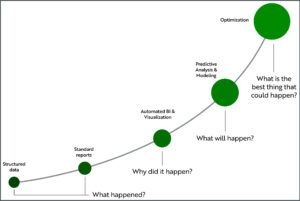The writer Daniel Djupsjöbacka is Head of Analytics & Optimization, Information Management at Atea Finland. This column is published in English and Finnish.
As human beings, communication is what makes us connect. Without communication, we are lonely, unconnected islands in a large sea. Through communication we share our thoughts, feelings and ideas. We express ourselves. We listen. Communication is the way we associate with other people. It is a large part of what makes a great day.
Effective communication is required in most successful careers. Good, solid communication is the basis of a genuine relationship and a family working well together.
What makes a great communicator? The writer and leader Larry Hagner says:
”The best speakers in the world are the best storytellers. They have a gift to not only tell a great story, but also share a lot of the details that many others wouldn’t.”
What or why?
Great communication is thus about more than giving the facts. If we are only interested in facts, we will ask, ”What happened?”
Communication with storytelling and details is more than solely telling the facts. Stories and details raise an interest in us, they make us curious. They make us want to understand, to know more; ”Why did it happen?” The plain facts become interesting, we become absorbed and involved.
The two questions mentioned here are really two ways of communicating. The answer to ”What happened?” is plain, one-dimensional. Like a command.
The answer to ”Why did it happen?” is open and unifying. We want to know more, to understand better, to gain more insight.
The difference between standard reporting and Business Intelligence
What does great communication have to do with Business Intelligence (BI) and BI applications?
One important way of communicating in an organization is by sharing information. Standard reports are communication, but they are limited and contain plain one-dimensional information. They will only answer the question ”What happened?”
Standard reports fail to create lasting curiosity and interest. They cannot answer any follow-up questions. They contain information, but nothing more.
BI takes information sharing to a new level. Instead of just delivering the information, good BI gives the user the opportunity to answer the question, ”Why did it happen?” It delivers concise top-level information while also empowering the user to drill down in data, compare with previous periods, understand relationships and chart information in a clear way.
BI takes information sharing to a new level.

With effective BI, the user can find information that clarifies relationships, gives new insights and allows for exploring what-if scenarios. It makes us curious, interested and hooked.
As we understand why, not only what, we are able to make better and more rational decisions.
Powerful BI is to business what great speakers are to communication. They are the best storytellers. They tell a great story, while also sharing a lot of the details. Effective BI applications are the world’s best digital communicators.
READ ALSO:
Ted Wallin: ”Is a company’s primary goal to maximize shareholder profit?”

